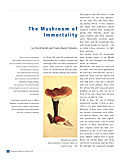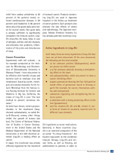|
||||||||
|
The Mushroom of ImmortalityIn China, the Ling-Zhi mushroom has been known for its highly curative and vitalizing effect for many hundreds of years. Now scientific research confirms its extraordinary healing properties for cardiac diseases and cancer.by Ulrich Arndt and Frank-Daniel Schulten Cancer Prevention Experiments with cell cultures – as for example conducted at the Institute for Microbiology and Biochemistry of Sklowodowska University in Warsaw, Poland – have also proven to be effective with harmful viruses and bacteria such as smallpox virus and streptococci (causing scarlet, meningitis and cardiac diseases). For Dr. Fukumi Morishige from the famous Linus Pauling Institute for Science and Medicine in Big Sur, California, the intake of Ling-Zhi is even “the best method to prevent cancerous diseases.”
As
tests have shown, certain polysaccharides in the mushroom (long-chained
carbohydrates, so-called Beta-D-Glucans), among other things, inhibit
the growth of tumors (see box). The Center of National Federation
of Studies in Cancer Development in the United States and the Medical
Department of the National Universities in the USA therefore attested
Ling-Zhi a healing effect on cancer.
Surprisingly, this herbal remedy is not well known in the West,
whereas in Asia it is very famous and esteemed: in Japan alone
the actual turnover of Ling-Zhi products and other healing mushrooms
exceeds 770 million U.S. Dollars per year. The explanation is simple:
until some time ago Ling-Zhi was available in limited quantity
only. Only a few years ago this mushroom began to be successfully
and professionally cultivated in large quantities. Since then,
the amount of scientific research on this traditional remedy has
exploded.
Besides its healing and harmonizing influence on the whole organism, Ling-Zhi is also said to have a psychic and spiritual effect. As this mushroom balances the Qi in the body, that is the opposing forces of Yin and Yang, it can also help to reach that equilibrated state which enables a deep meditation to begin with. In this way the “sacred mushroom” supports the inner collection and prepares body and mind for higher levels of awareness.
|
Für weitere Informationen beachten Sie auch die Partnerlinks
Bitte beachten Sie:
Die Informationen dieses webs sind journalistische Aufbereitungen des
jeweiligen Themas und ersetzen keine medizinische Beratung. Bei
gesundheitlichen Problemen und Erkrankungen suchen Sie bitte zuerst einen
Arzt oder Heilpraktiker auf. |
|
|
| |
Home |Impressum |Datenschutz | Links | Bücher
& Seminare | Suche | | Heilmittel | Alchemie | Diagnose | Therapien | Selbsthilfe & Ernährung | Spiritualität & Wissenschaft | Urwissen | Denken & Handeln | Freizeit | |
| © horusmedia.de Ulrich Arndt Rechtliche Hinweise |
|
Bitte beachten Sie: Die Informationen dieses webs sind journalistische Aufbereitungen des jeweiligen Themas und ersetzen keine medizinische Beratung. Bei gesundheitlichen Problemen und Erkrankungen suchen Sie bitte zuerst einen Arzt oder Heilpraktiker auf. Ausdrücklich sei zudem darauf hingewiesen, dass in Artikeln eventuell beschriebene Methoden, Therapien, Hilfsmittel und Nahrungsergänzungen lediglich Hinweise und Verfahren einer alternativen, esoterischen oder traditionellen Erfahrungs-Heilkunde darstellen und keine Heilmittel und anerkannte Therapieformen im Sinne der heutigen Schulmedizin sind. copyright - Urheberrecht Rechtliche Hinweise Die Urheberrechte sämtlicher Texte liegen, sofern nicht ausdrücklich anders gekennzeichnet, bei Ulrich Arndt (im Folgenden der Autor genannt). Inhalte dürfen nur zu Informationszwecken und nicht zum Verkauf oder zur Verbreitung zu gewerblichen oder politischen Zwecken verwendet werden. Kein Artikel, kein Auszug aus einem der Texte, keine Grafik oder Bild dürfen ohne schriftliche Zustimmung des Autors in irgendeiner Weise vervielfältigt, verbreitet oder öffentlich wiedergegeben werden. Ohne schriftliche Einwilligung des Autors dürfen die Datenbank oder Teile von ihr auch nicht in von Datenverarbeitungsanlagen verwendbare Sprachen übertragen oder übersetzt werden und dauerhaft gespeichert. Ausgenommen hiervon sind nur Vervielfältigungen, die technisch zum Zwecke des Einblicks in die Datenbank unumgänglich sind und nur vorübergehend vorgenommen werden. Die Urheberrechte an Bildern und Grafiken liegen manchmal beim Autor, manchmal bei den Zeitschriften, in denen die Artikel erschienen sind, oder bei Dritten. Jegliche Nutzung bedarf der schriftlichen Zustimmung des jeweiligen Rechteinhabers. Der Autor behält es sich ausdrücklich vor, Teile der Seiten oder das gesamte Angebot ohne gesonderte Ankündigung zu verändern, zu ergänzen, zu löschen oder die Veröffentlichung zeitweise oder endgültig einzustellen. Markenrecht Alle in Artikeln eventuell erwähnten Marken- und Warenzeichen unterliegen uneingeschränkt den Bestimmungen des jeweils gültigen Kennzeichenrechts und den Besitzrechten der jeweiligen Eigentümer. Verwendungen bedürfen der schriftlichen Zustimmung des Marken- und Rechteinhabers. Links Einige Seiten dieser Website enthalten Links zu externen Websites. Diese Links ermöglichen Ihnen den Zugang zu weiteren Informationen bestimmter Themen. Trotz sorgfältiger inhaltlicher Kontrolle zum Zeitpunkt der Verlinkung übernimmt der Autor keine Verantwortung und Haftung für die Inhalte externer Links. Für den Inhalt der verlinkten Seiten sind ausschließlich deren Betreiber verantwortlich. Haftungsausschluss Der Autor hat die Informationen der Artikel nach seinem Stand des Wissens zum Zeitpunkt der Entstehung des Artikels und mit journalistischen Sorgfalt erstellt. Sollten sich dennoch unvollständige, fehlerhafte oder illegale Informationen eingeschlichen haben, so bittet der Autor um Entschuldigung, übernimmt aber keinerlei Haftung. Mit den Artikeln dieser Website sind keine Angaben und keine Gewähr zur Eignung der darin enthaltenen Informationen für einen bestimmten Zweck verbunden. So übernimmt der Autor keine Gewährleistung und Haftung im Zusammenhang mit jeglicher Nutzung der Informationen auf dieser Homepage, und in keinem Fall kann er haftbar gemacht werden für besondere oder indirekte Schäden, Folgeschäden, entgangenem Gewinn oder sonstige Handlungen, die aus Nutzung der Informationen resultieren. Sofern Teile oder einzelne Formulierungen dieses Textes der geltenden Rechtslage nicht mehr oder nicht mehr vollständig entsprechen sollten, bleiben die übrigen Teile des Dokuments in ihrem Inhalt und ihrer Gültigkeit davon unberührt. |


 Ganoderma
Lucidum
Ganoderma
Lucidum